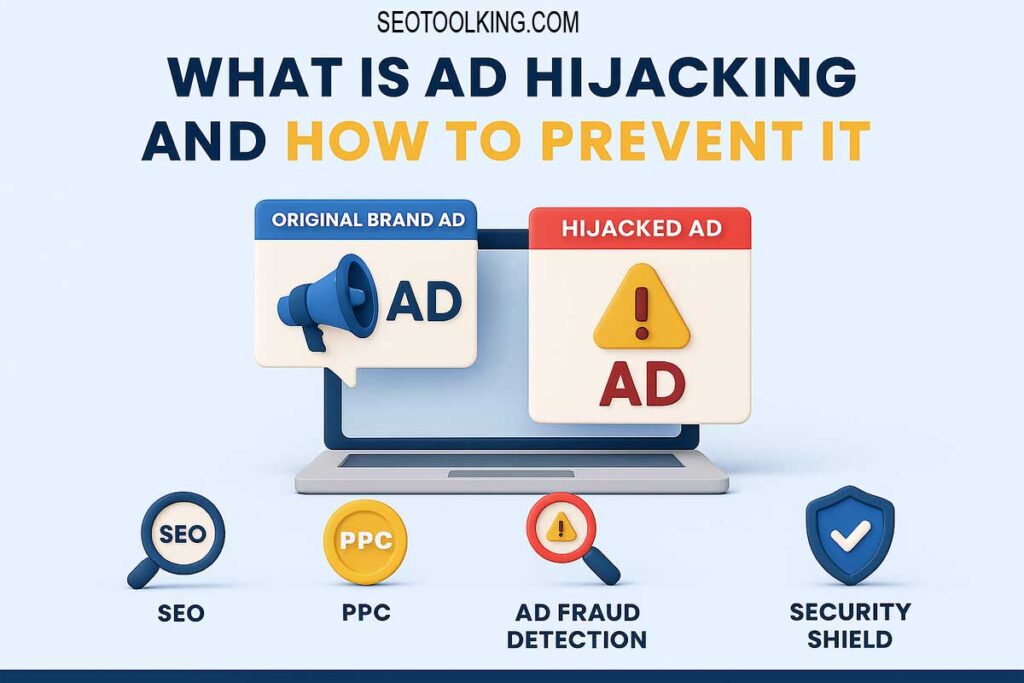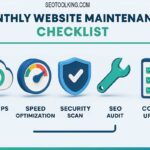In the fast-paced world of digital marketing, where every click counts and ad budgets are tight, a growing threat is costing brands thousands of dollars every month — Ad Hijacking.
This sneaky form of PPC fraud manipulates your paid advertising campaigns, stealing traffic, damaging your brand, and draining your ROI without you even realizing it.
In this guide, you’ll learn:
✅ What ad hijacking is
✅ How it affects your paid campaigns
✅ How to detect it
✅ Proven ways to stop it
What Is Ad Hijacking? (Simple Definition)
Ad Hijacking occurs when a third party — usually an affiliate or competitor — copies your paid ads and runs them using your brand name to steal traffic and commissions.
In many cases, these hijackers pretend to be your brand, showing the same ad copy and link — but redirecting users to their own tracking URLs or fake pages.
Example:
Let’s say your brand runs an official Google ad for “Buy Nike Running Shoes Online”.
A hijacker creates a copy of your ad, using your brand name:
“Official Nike Store – 50% Off Running Shoes”
When users click, they’re redirected to a fake affiliate link or counterfeit website.
You pay for the click — they get the conversion.
Why Ad Hijacking Is Dangerous for Your Brand
Ad hijacking doesn’t just waste money — it damages trust, reputation, and SEO credibility.
Here’s what it costs your business:
- Lost Revenue:
Hijackers steal your traffic and conversions — while you still pay for the clicks. - Brand Reputation Damage:
Fake ads with misleading offers harm your credibility and confuse your customers. - Misleading Analytics:
Your ad data becomes unreliable — affecting optimization and remarketing strategies. - Affiliate Fraud:
Dishonest affiliates inflate commissions by hijacking your ads. - Legal Risks:
If hijacked ads violate ad policies (e.g., misleading claims), your ad account could be penalized.

Common Types of Ad Hijacking
Knowing how hijackers operate helps you stop them early.
1. Affiliate Ad Hijacking
Affiliates clone your paid ads, redirecting users through their affiliate links to earn unfair commissions.
2. Competitor Ad Hijacking
Competitors run similar ads targeting your branded keywords to steal your traffic.
3. Malware-Based Hijacking
Malicious extensions or apps inject hijacked ads on search results, replacing your legitimate ones.
4. Landing Page Hijacking
Hijackers create fake landing pages that mimic your site, capturing user data or sales.
How Ad Hijacking Affects SEO and PPC Performance
Even though hijacking happens in paid ads, it indirectly harms your SEO strategy too.
Here’s how:
- Inconsistent brand signals confuse Google’s algorithm.
- CTR and engagement drop when users see misleading ads.
- Duplicate ad content dilutes brand authority.
- Hijacked traffic skews keyword and performance data.
👉 Use our Free SEO Audit Tool to detect duplicate content, broken links, and brand inconsistencies caused by hijacked ads.
How to Detect Ad Hijacking
Ad hijacking can be hard to spot manually, but these methods help uncover the issue:
1️⃣ Use Ad Monitoring Tools
Platforms like AdPolice, BrandVerity, or Semrush Brand Monitoring detect when your ads or brand keywords are being copied.
2️⃣ Search Your Branded Keywords
Regularly Google your brand name or product name. If you see ads that look like yours but have different URLs, that’s a red flag.
3️⃣ Track Affiliate Behavior
If you use affiliates, monitor their conversion patterns. Sudden spikes may indicate fraudulent ad activity.
4️⃣ Analyze PPC Metrics
Watch for unusual drops in impressions, spikes in CPC, or unexplained traffic loss — all signs of hijacking.
How to Prevent Ad Hijacking
Protecting your ad investment requires monitoring + strict affiliate and brand control.
✅ 1. Trademark Your Brand Name
Register your brand with Google Ads. Once verified, Google restricts others from using your trademark in ads.
✅ 2. Set Clear Affiliate Rules
Specify in contracts that affiliates cannot bid on your brand keywords or use your ad copy.
✅ 3. Use Brand Monitoring Tools
Tools like AdWatcher or The Search Monitor notify you instantly when hijackers clone your ads.
✅ 4. Block Suspicious IPs and URLs
If you detect suspicious traffic sources, block those IPs in Google Ads or your analytics dashboard.
✅ 5. Audit Your Ads Regularly
Perform manual searches for your brand and track your ad performance metrics weekly.
👉 Try our Keyword Rank Tracker Tool to monitor keyword performance and detect suspicious shifts.
Example: How a Brand Beat Ad Hijacking
Scenario:
A fitness brand noticed a drop in conversions despite a stable ad budget.
Investigation:
They found two hijacked ads running under their brand name, redirecting users to fake landing pages.
Action Taken:
- Trademarked their brand name on Google Ads
- Used AdWatcher to monitor brand keywords
- Contacted Google to remove fraudulent ads
Result:
✅ Click fraud stopped
✅ Conversions increased by 28%
✅ Brand CTR recovered within 2 weeks
Recommendation
👉 Boost your ad performance and brand protection with:
FAQs About Ad Hijacking
Q1: How do I know if my ads are being hijacked?
Search for your brand’s ads manually or use monitoring tools like AdPolice and BrandVerity.
Q2: Can ad hijacking happen on social media ads?
Yes. Hijackers can clone Facebook, Instagram, and TikTok ads with fake landing pages.
Q3: Does Google ban ad hijackers?
Yes, but only if reported. You need to provide evidence of trademark violations.
Q4: What’s the best way to prevent ad hijacking?
Trademark your brand name and monitor your ads weekly.
Q5: Is affiliate ad hijacking illegal?
Yes — it’s considered affiliate fraud and violates most ad platform policies.
ad hijacking, google ads hijacking, ppc ad hijacking, affiliate ad fraud, prevent ad hijacking, paid ad protection, click fraud prevention, ad monitoring tools, brand protection in advertising
Conclusion: Protect Your Ad Spend Before It’s Too Late
Ad hijacking is a silent, invisible threat — and it can drain your marketing budget before you notice.
To stay safe:
- Monitor your brand ads regularly.
- Protect your trademarks.
- Use analytics and detection tools.
Remember: prevention is cheaper than recovery.
👉 Run a Free SEO and PPC Audit on your website today to safeguard your ads and track your brand visibility in real-time.


